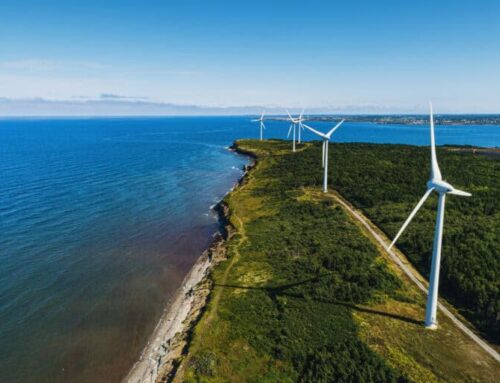Rystad Predicts Global Emissions Peak by 2026 as Clean Power Surges
October 31, 2025
The global energy system is witnessing the next greatest transition, standing on the cusp of a new energy era championed by clean electricity and the increased adoption of electrification across the board. Rystad Energy is pleased to announce the release of its flagship annual report, Global Energy Scenarios (GES) 2025, which provides in-depth degree scenarios toward 2100 and a newly developed nationally determined contribution (NDC) scenario to 2035. Clean electricity and electrification are expanding faster than any shift in modern history, with energy sources of the next era growing from around 9% in 2015 to more than 14% this year as a share of primary energy.
While nations grapple with the dual challenge of addressing climate change and strengthening energy security, renewables are expanding faster than any previous energy technology, with total wind and solar capacity additions for 2024–2025 set to exceed 700 gigawatts (GW). Because of this, our research indicates that a 1.9-degree Celsius trajectory – referring to an average global temperature rise above pre-industrial levels – is more likely toward 2040, as a hybrid energy ecosystem is now in place.
As these scenarios play out, the transformation of the global energy system requires three clear steps:
Task 1: Clean up and grow the power sector
Cleaning up and expanding the power sector plays a dominant role in reducing emissions through 2050. Our analysis indicates that achieving a global warming scenario more ambitious than 1.9 degrees Celsius will require at least 90% of the identified opportunities for a reduction in emissions to be realized.
Task 2: Electrify almost everything
Electrification becomes particularly impactful in pathways that limit warming at or below 1.6 degrees. The greatest contribution comes from the adoption of electric vehicles (EV), alongside widespread energy efficiency improvements across buildings, industry, and transport.
Task 3: Address residual emissions
Addressing residual fossil fuel use through CO? capture or substitution with low-carbon fuels contributes little to a net reduction in emissions before mid-century in pathways exceeding the 2.2-degree scenario. This limited impact reflects its later-stage deployment and higher costs.

Download your copy of Global Energy Scenarios 2025.
Already today, we’re seeing the energy system shift to a hybrid model of renewable and fossil energy. With half of global power generation capacity now renewable and one in four new cars sold being electric, the energy system is transforming rapidly. There are already clear signs of change across investments, new capacity additions, and technological adoption curves that indicate we will witness a genuine transition over the next two to four decades.
Jarand Rystad, founder and CEO, Rystad Energy
Although the transition to renewable energy is gaining momentum, oil and gas are expected to remain resilient in the near term. Oil demand is projected to peak by the early 2030s, and gas growth will likely slow down towards the end of this decade; however, neither fuel experiences a sharp contraction. The energy transition is fast enough to alter the growth profile of fossil fuels, but not fast enough to deeply disrupt their dominance by 2040. Oil and gas remain the backbone of the system, tied to transport, petrochemicals and energy services, where alternatives are not yet cost-competitive or scalable. This transition will have significant implications for costs and investments, as fossil fuel growth slows down and they are outpaced by renewables, ultimately leading to lower costs for consumers over time.

Looking ahead, we can clearly outline five pathways that will shape the global energy outlook, which include the Rystad Energy NDC, 1.6 degrees Celsius, 1.9 degrees Celsius, 2.2 degrees Celsius, and the Rystad Energy House View scenarios. Global CO? emissions are expected to peak around 2026 before starting a gradual decline, driven by rapid renewable deployment in power and EV adoption in transport. This marks a turning point, showing that the world is moving from growth to decline in emissions. However, current NDCs remain far from sufficient to limit warming to 1.5 degrees. Even if fully implemented, they would not achieve the substantial reductions necessary for achieving the lower range of the Paris Agreement.

Our prediction of a 1.9-degree Celsius scenario is heavily predicated on renewable energy installations setting all-time high records and serving as the backbone of new power growth, with solar leading the pack. Solar is forecast to rise from 1,868 GW in 2024 to 2,412 GW in 2025 – a 544 GW increase that cements its position as the leader of new global power generation. Record manufacturing output, sustained cost declines, and accelerating deployment in China, India, and the US drive the expansion.

Fueling this exponential growth in renewable energy development is a global increase in low-carbon investments. Currently, low-carbon technologies attract over $900 billion annually, compared to $735 billion for oil and gas. This $181 billion delta widens to an estimated $391 billion by 2030, reflecting a complete shift in growth dynamics. The installed base changes slowly, but investment is a leading indicator: today’s capital flows determine the 2040 energy system. By 2030, low-carbon sources are set to capture 46% of all energy investment, compared to 30% for fossil fuels, with grids accounting for 24%.
By Jon Ødegård Hansen, Lars Nitter Havro, and Katie Keenan at Rystad Energy.
More Top Reads From Oilprice.com
Oilprice Intelligence brings you the signals before they become front-page news. This is the same expert analysis read by veteran traders and political advisors. Get it free, twice a week, and you’ll always know why the market is moving before everyone else.
You get the geopolitical intelligence, the hidden inventory data, and the market whispers that move billions – and we’ll send you $389 in premium energy intelligence, on us, just for subscribing. Join 400,000+ readers today. Get access immediately by clicking here.
Search
RECENT PRESS RELEASES
Related Post




